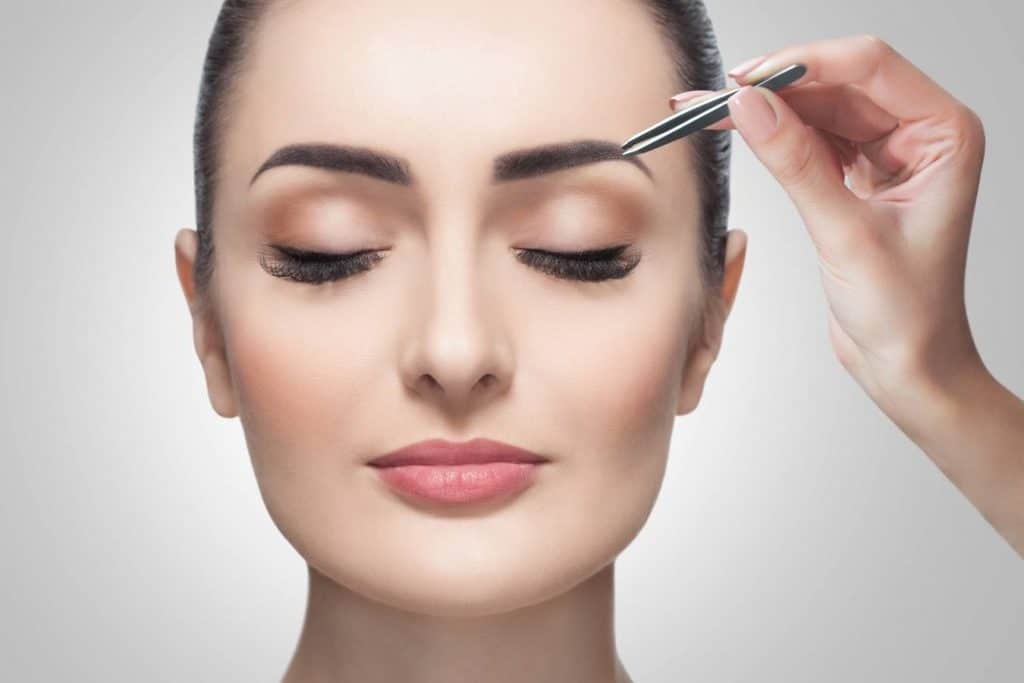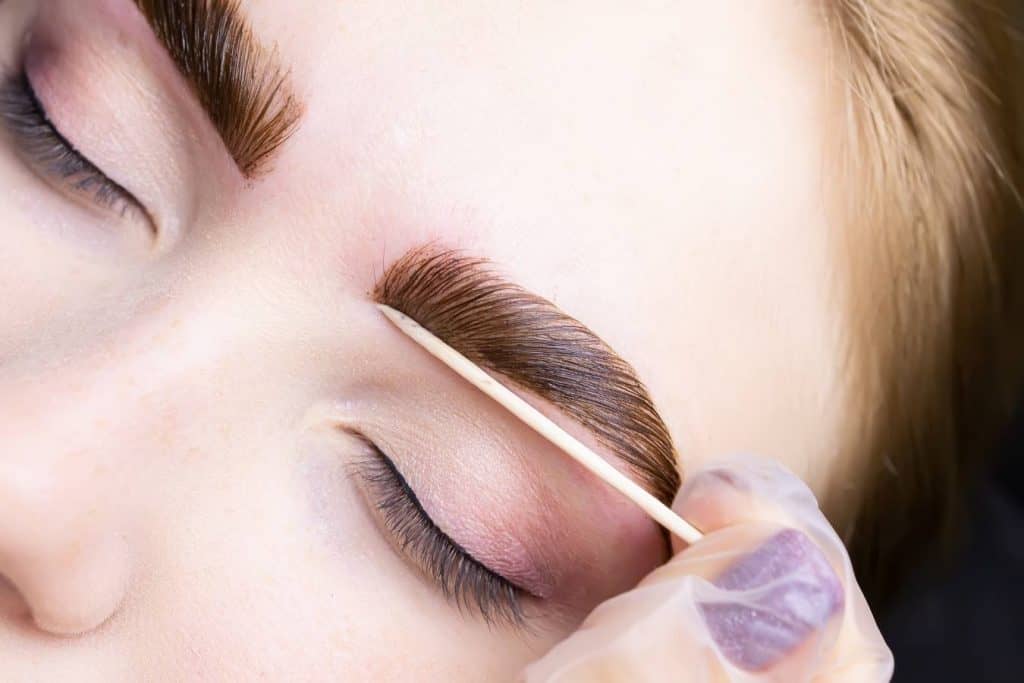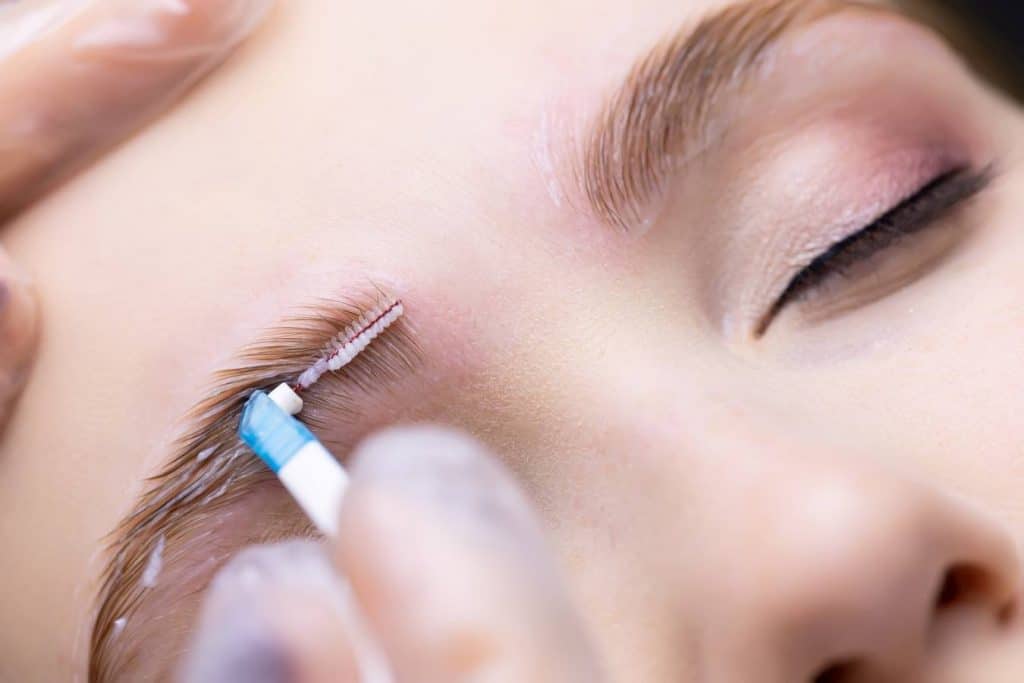Regular tint and henna eyebrows both add color and definition to the eyebrows. Here is a quick guide to the two treatments and how they compare.

The main difference between regular tint and henna eyebrows is that regular tint is much more subtle and natural-looking than henna eyebrows. A regular tint is also easier to apply than henna eyebrows and comes in a wider range of colors. Its effect, however, is shorter-lasting and it can be harsh on hair and skin.
What Are Henna Brows?
Henna brows treatments use henna dye to stain the eyebrow hair and the skin behind it.
The fact that henna stains the skin, as well as the hair, means that the brows can be shaped as well as colored.
Henna dyes produce rich, warm tones and add volume and gloss to the hair.
This means that the overall effect of henna brows is very powerful and dramatic.
What Is A Tint?
A tint is essentially the same as a regular hair dye but for the eyebrows.
Tints color the hair but have little to no effect on the skin. This means that they cannot be used to shape the eyebrow in the same way as henna dyes can.
They simply enhance the natural color of your brows and hence give them more definition.
It goes without saying but you should never use normal hair dye on your eyebrows as this is far too strong to be used in such a sensitive area of the face.
7 Differences Between Henna Brows And A Tint

Here is a quick rundown of the seven main differences between henna brows and a tint:
1. Henna brows are more dramatic than tint
Henna brows bring drama and definition to your eyebrows as well as bold color.
Tint subtly enhances the natural appearance of your own eyebrows.
This means that henna brows make a clear statement whereas tint is much more subtle and hence realistic, especially close up.
2. Henna brows last longer than tint
Henna brows are at their most dramatic for about a week after the henna brows treatment.
This is the time when the henna stain is on the skin as well as the brow hair.
The overall effect, however, can last for 6-8 weeks.
With regular tint, any staining of the skin is minimal. If it does happen, it will last for 1-3 days at most. The overall effect will last for 2-3 weeks.
3. Henna brows are more natural than tint
High-quality henna dyes are made wholly or mostly of ground henna leaves and distilled water. Some henna dyes may have other ingredients to expand the range of colors.
With high-quality henna dyes, any additional ingredients will also be plant-based. For example, high-quality black henna dye will usually be colored with indigo.
Tints are generally based on plant dyes. They do, however, usually include other chemicals, sometimes very harsh ones.
Most tints use peroxide as an activator. Some also use ammonia and/or lead.
4. Henna brows are kinder to hair than tint
Henna moisturizes, nourishes, and conditions your hair (and skin) while coloring it.
Tints, by contrast, will dry your eyebrow hair and possibly also dry the skin behind it.
You can counterbalance this, at least to some extent, by using conditioning treatments. These treatments may, however, cause the tint to fade even faster.
5. Henna brows are unlikely to trigger a reaction
High-quality henna dyes are highly unlikely to trigger any sort of reaction. Low-quality henna dyes, by contrast, often do contain harsh chemicals.
In particular so-called “black henna” (also called neutral henna) is often made with paraphenylenediamine (PPD).
This is a known allergen and is definitely best avoided as it can trigger a serious reaction.
Tints, by contrast, almost always contain peroxide (as an activator). They can also contain other harsh chemicals.
This means that they are much more likely to trigger a reaction.
6. Henna brows are available in fewer colors than tint
Henna dyes are now available in a range of browns and black as well as the traditional red.
Tints, by contrast, are available in every color from gray and ash blonde to black through every variation in between.
7. Henna brows are harder to apply than tint
Henna dye is a thick paste that needs to be applied to exactly the right parts of your brow with an exactly even consistency.
It then needs to be left to develop for exactly the right length of time.
It is very hard to get all this right when treating yourself.
What’s more, if you get it wrong, your mistakes will probably be very obvious, although they’re usually treatable.
Regular tint, by contrast, is much easier to apply even when treating yourself. The fact that the effect is more subtle means that it’s more forgiving of mistakes.
You also have less time to wait until the dye fades naturally taking your mistake with it.
Henna Brows Vs Tinting- Which Is Right For You?

Henna brows and tinting are both great ways to add color and shape to your eyebrows. Which one is right for you depends largely on your beauty goals.
Reasons To Choose Henna Brows
Here are the three main reasons to choose henna brows:
1. You want a more dramatic effect
If you want brows with wow then having a henna brows treatment is the way to go.
It’s vastly more dramatic than any other eyebrow treatment, including semi-permanent tattoos. Henna brows really make your brows a highlight of your face.
2. You want a longer-lasting effect
With henna brows, the stain on the skin tends to last for about a week. The stain on the lashes tends to last for 6-8 weeks.
This is nowhere near as long as for semi-permanent tattoos. It is, however, a lot longer than for regular tint.
3. You want a dye that cares for your hair
Henna dyes are not just free of harsh chemicals such as peroxide, ammonia, and lead.
They are also packed full of Vitamin E, antioxidants, and proteins. This means that henna dyes actually nourish and protect your hair.
Regular tint, by contrast, can strip it of its natural oils.
Reasons To Choose Tinting
Here are the three main reasons to choose tinting:
1. You get a more natural look
Just as you don’t wear evening wear in the daytime, you don’t necessarily want full-on drama for your eyebrows all the time. Regular tint is more subtle than henna brows.
Regular tint is essentially a slight improvement to your natural eyebrows rather than full-on “wow”.
You can then use normal makeup if you want to create a bolder look on specific occasions.
2. You want an easy-to-use treatment
Henna dye is a paste. It’s notoriously difficult to apply accurately and mistakes can be very noticeable.
There are ways to fix bad henna eyebrows but many people prefer just to avoid the problem in the first place.
One way to do this is to have your henna brows done in a salon. If, however, you want or need to do home treatments, regular tint is much easier to use.
Also, it’s more subtle and shorter-lasting than henna dye. This means that any mistakes will be less noticeable and gone more quickly.
3. You want a wide choice of colors
Traditional henna dye produces a reddy-brown color. Modern henna brow dyes are now available in various shades of brown, and black.
This means that they tend to be most suitable for people with brown, black, or red/auburn hair.
People with warm blonde hair (e.g. honey blondes) might also suit henna brows.
If, however, you have cooler-toned hair (e.g. ash blonde or gray), then henna brows could easily overpower your face.
A regular tint is usually a much better option here.
Even if you do have darker hair, you might still find that tint provides a more natural color match than henna brows.
This is simply due to the fact that it’s much easier to fine-tune the color of a tint than it is to fine-tune the color of henna dye.
